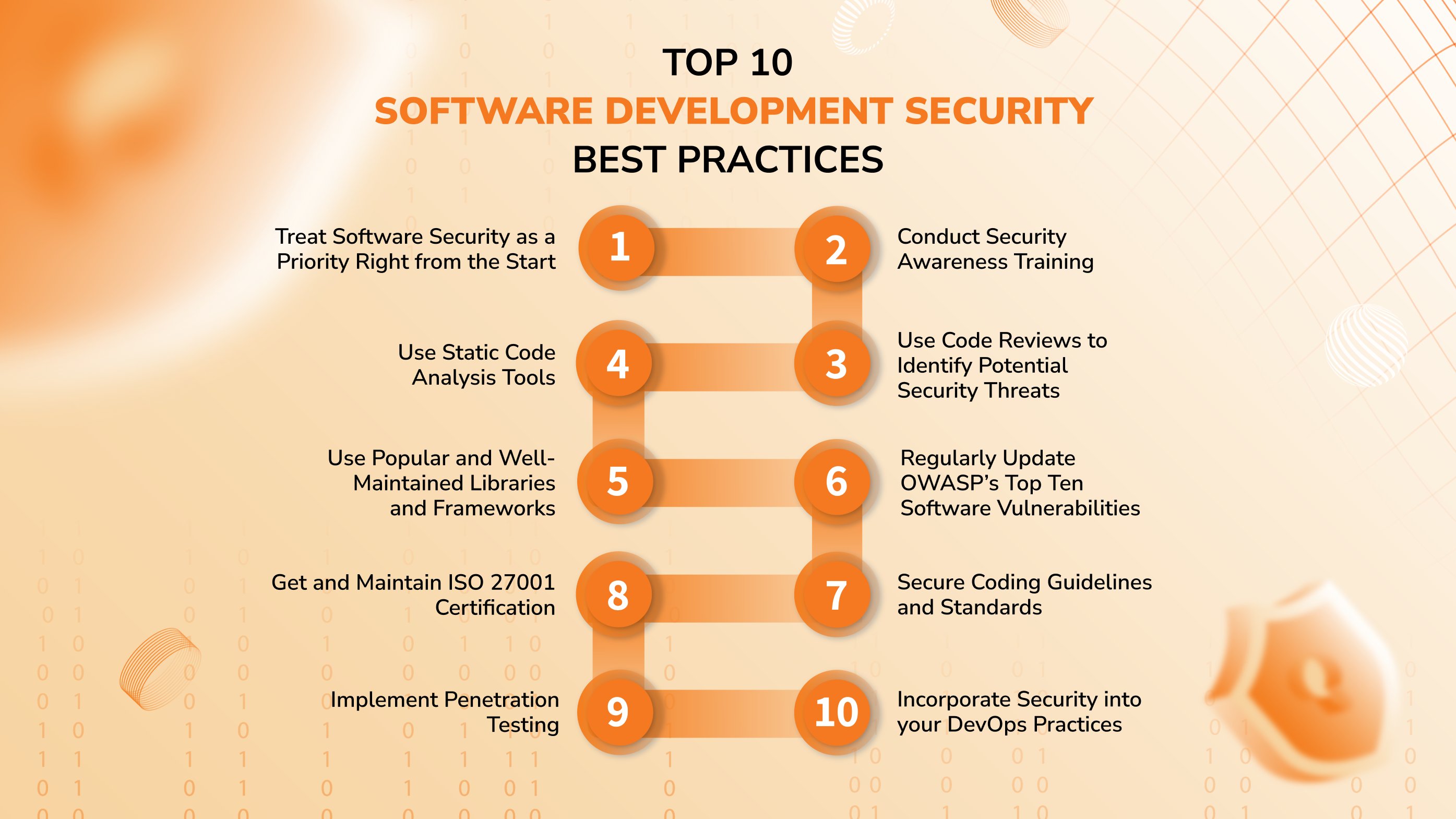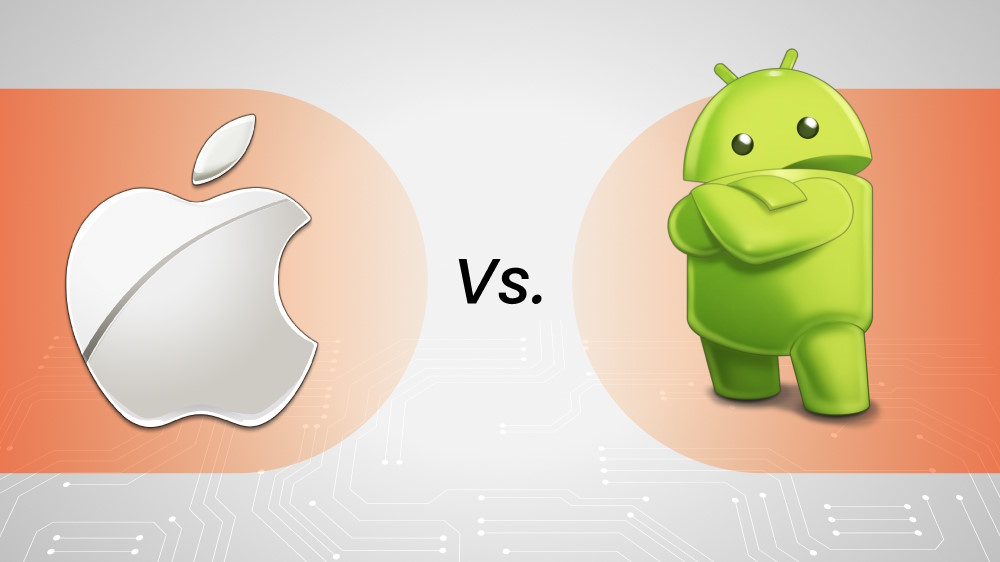Top 10 Best Practices for Software Development Security
Rather than an option, setting the highest level of security in the software development process is a top priority for maximizing product quality. From necessary definitions to best practices, all will be revealed in this article.

Content Map
More chaptersSoftware development has become an integral part of our lives, and we rely on it for almost everything we do. Thanks to the help of technological advancements, types of software products that were already modern and efficient are becoming more complex and superior with many new user-friendly improvements. Tech breakthroughs, unfortunately, also introduce new potential methods of security risks.
As cyberattacks show no signs of slowing, software security is a critical topic that should be given due attention. It is important for developers to follow best practices for software development security. The purpose of these best practices is to minimize any vulnerabilities in your code, protect it from hackers and cybercriminals, and maintain users’ privacy.
So, how do experts secure their software development life cycle (SDLC)? This blog post will list down some security best practices and frameworks that you should follow while developing your software applications.

What Is Secure Software Development?
Secure software development, or software development security, is the concept of implementing a set of practices, methodologies, and systematic processes into every step of the software development life cycle (SDLC) from initial design to deployment and maintenance to prevent and minimize potential vulnerabilities and attacks that may occur during the operation of the final product.
New methods of cyber security threats are developing and modernizing at a rapid pace. Any weakness or flaw in a software system can be easily exploited by attackers to gain unauthorized access, cause damage, or steal information. Rather than an option, promoting the highest level of security in the software development process is considered a top priority for maximizing product quality.
With software security development, development teams add an extra layer of protection to the released software, ensuring it always operates smoothly and error-free while adhering to mandatory security standards such as GDPR, HIPAA, PCI-DSS, etc.

Common Types of Security Practices
Network Security:
This involves creating a secure environment for seamless communication and data exchange between in-network devices. In order to achieve this level of protection, many components and practices, such as intrusion detection systems, firewalls, encryption, and access controls, have to be implemented in combination.
Endpoint Security:
This is the practice implemented to protect end-user devices, including computers, laptops, and mobile devices, from cyberattacks and exploitation by malicious actors. Investing in such methods helps businesses ensure that used devices are not entry points for any potential attack.
Cloud Security:
This refers to the set of technologies and policies deployed to secure software apps and infrastructure within the cloud computing environment. As companies are gradually shifting to cloud services for more efficient data management and storage, cloud security is increasingly important.
Application Security:
This revolves around integrating the tools, processes, and practices necessary for applications to ensure they operate smoothly without cyber threats like SQL injection and cross-site scripting throughout their lifecycle. Such a type of secure software development framework is required to deploy from the design phase through development, deployment, and maintenance to ensure the overall security of apps.
Information Security:
This is the practice of protecting information systems from unauthorized disclosure, access, or alteration, whose primary goal is to ensure the confidentiality, integrity, and availability of data.

What Are the Most Common Security Risks?
Before listing the best practices, it is vital to understand the most common security risks developers face. Some of the common security risks faced by software developers include:
Lack of Active Software Maintenance
If you are not developing your application anymore or being supported by a small team, there is a high chance that the software applications have vulnerabilities. Simply put, leaving an app without active maintenance or further updates causes it to become outdated over time, leading to many errors during operation. Once these vulnerabilities are exploited, hackers can access secure data and confidential information stored on your server, resulting in various security issues.
Poorly Written Code
Another common risk in software development is poorly written code, which can be characterized by a lack of readability, poor structure, inconsistent style, inefficient algorithms, duplication, etc. An application with poorly written code is challenging to secure, and coding practices such as input validation, output encoding, error handling, secure storage, and secure coding practices are often not followed.
Vulnerable Web Services
As web services allow different applications to communicate over the Internet, they can be susceptible to multiple security risks if they do not have proper security methods in place. Sensitive data related to the user and personal information transmitted back and forth through types of web services is considered a lucrative target for individuals seeking illicit profits. Once the web services have vulnerabilities, hackers could exploit them to access private information or perform unauthorized activities on your website.
Insecure Password Storage
Unfortunately, passwords are often stored in a way that makes it easy for attackers to steal and decrypt them using various techniques, such as dictionary attacks and brute force attacks. Storing passwords in plain text, using outdated or weak hashing algorithms (like MD5 or SHA-1), or lacking salting are some of the common reasons leading to vulnerabilities that facilitate unauthorized access and data collected.
Legacy Software
Legacy software is vulnerable to security attacks. Built with hardware or software components that are no longer supported, the legacy systems themselves are outdated. They are usually written with insecure coding practices and are not updated frequently, making them prone to cyber-attacks and data breaches. As legacy software operates over time with increasing customization, it becomes more complex and makes it difficult for developers to identify and fix vulnerabilities without disrupting functionality.

Why Do Developers Skip Security Preparations?
While secure software development is a necessary process, developers often skip it for various reasons.
The most common reason is time and resource constraints. Developers often find themselves in a dilemma where they have too much work on their plate and not enough time or resources for everything that needs to be done before the release date. As a result, they end up taking shortcuts by focusing only on what’s required at the moment.
Another reason is a lack of awareness about potential threats. Most new software products are good at delivering performance. However, whether they can maintain it in the later stages of the product lifecycle is questionable. Unfortunately, many programmers believe that hackers will never attack their applications, so there’s no need to perform secure software development steps during the development phase, which can eat into precious person-hours.

Why Is Secure Development Lifecycle Important?
As the future is uncertain, a new application once to be error free may encounter unexpected issues during operation if lacking of proper maintenance and upgrades. Securing software development in this situation acts as insurance for types of software products.
The World Economic Forum’s Global Risks Report 2024 found that cyber insecurity is a global risk over multiple time horizons. Rather than an option, secure software development is increasingly becoming a necessity. The main purpose of implementing top best practices into SDLC is to ensure consistent software quality and to fix potential vulnerabilities before they have a chance to emerge.
That’s the big picture. The benefits that a business gets from applying best practices for software development security go beyond that, which include:
Data Protection
Protect sensitive data from unauthorized access, theft, or breaches.
Trust and Reputation
Build trust and reputation with customers and partners.
Financial Loss Prevention
Timely detect and prevent security vulnerabilities before they happen.
Compliance and Legal Requirements
Ensure compliance with regulations like GDPR or HIPAA.
Business Continuity Assurance
Prevent disruptions caused by cyberattacks.
User Experience Enhancement
Provide a safer and more reliable product-using experience.

Top 10 Software Development Security Best Practices
Let’s go through some of the best secure software development practices that should be included throughout your SDLC.
Security should be considered from the planning stages of your project. Security starts with requirements, so it is essential to think about what vulnerabilities may come up in each stage of software development. This means that security should always be evaluated when making changes or adding features later on down the line.
A secure software development lifecycle (SDLC) is a way to develop secure applications. It takes into account the security risks involved throughout the entire application lifecycle. Furthermore, it works through each phase to ensure that appropriate controls are implemented at every process step.
Your software developers need to know what they are up against. They should be informed of common attacks in the software development world and how to avoid them.
Security awareness training should include information about common software development vulnerabilities. It should also include information about how hackers and cybercriminals work.
Developers need to know what mistakes they are likely to make when writing code to avoid making those same mistakes themselves. Education and knowledge transfer will help your software developers write secure applications from day one.
As part of security awareness training, it’s good to hold regular meetings where everyone gets together and discusses secure development practices. These meetings can be very beneficial when it comes to identifying vulnerabilities in your code before cyber-attackers do!
Code reviews help developers identify and fix security vulnerabilities so they can avoid common pitfalls. Secure design is an integral part of software development. When writing code, adopt a defensive mindset that helps you write as little code as possible. You should also be testing your code and writing unit tests for all areas of concern.
For every code change you make, you should go back and check to see if those changes have introduced any new security vulnerabilities. In addition, it is essential to review security requirements to ensure that secure coding practices are followed throughout the development process.
Security mistakes can sometimes seem subtle and can be easily overlooked by experienced developers. Static code analysis tools can bridge this understanding gap, find security vulnerabilities, and facilitate code review processes.
Before your software is deployed, static code analysis tools are an excellent approach to finding software vulnerabilities. It can be integrated into the pipeline so that every time there is a new build, it will automatically run through these checks and flag any potential issues.
During a security code review, static code analysis tools may be used to identify areas of concern. These tools are essential for large organizations where developers may come and go or lack security knowledge.
Static code analysis tools are not perfect, but they can certainly help catch some of the most common issues that lead to software vulnerabilities, such as SQL Injection, Cross-Site Scripting (XSS), and sensitive data exposure.
It is best to use popular, well-maintained libraries or frameworks when writing software since they are less likely to have vulnerabilities than newly created code bases.
Using open-source components can help you better manage your software security since you can benefit from early bug detection and patches. In addition, using secure software development libraries can help reduce your application’s attack surface and make it more secure.
Developers should always research the reputation of a library or framework before using it extensively in their applications. They can use online tools that provide detailed information about each project’s community activity, release frequency, and other metrics, which will help them make an informed decision on whether this component is secure enough for their needs.
Get your team to know OWASP’s Top Ten Software Vulnerabilities. These web application security flaws are the most common mistakes that secure software development best practices avoid.
Having an updated list of the top software vulnerabilities in one place makes it easy for developers to ensure that they are taking steps to avoid these common errors. Even if your team is not familiar with OWASP, knowing their most important points will help you decide how best to secure your software development projects.
Secure software development starts with coding guidelines and standards. Your organization’s secure coding guidelines and measures should be defined by a consensus of experts, taking into account industry best practices.
Secure coding standards can help promote better design principles within an organization, which reduces vulnerabilities before software goes live. Moreover, by providing a standard set of rules and restrictions regarding what kind of code gets written, teams can enforce reliable testing methods throughout the Software development lifecycle to ensure that they are not introducing new vulnerabilities.
Threat modeling is another technique that software developers should use to secure software. Threat modeling identifies threats by looking at specific data flows and then analyzing what can go wrong within each flow.
Here are some concepts that developers should know to create secure coding guidelines:
- Encryption
All data should be encrypted in transit and at rest. This includes database storage, file storage, sessions, cookies, etc. Encryption is the only way to maintain the confidentiality of user data on a network where any node can potentially become compromised by an attacker who will have full access to all traffic they observe (i.e., plain text).
- Password Hashing
To secure passwords, never store them in plain text. Instead, use a password hashing algorithm to compute a unique hash of the user’s password that can be stored in your database.
- SQL Injection
SQL injection attack is when a hacker inserts a SQL query through an application interface to extract or manipulate data from the back-end database. SQL injection attacks can be prevented by using parameterized queries instead of dynamic SQL statements.
- Cross-Site Scripting (XSS)
XSS is a type of attack that occurs when an attacker injects malicious scripts into the application. This kind of attack aims to get users to click on links that will then send them to malicious sites or have software deliver malware directly onto their devices without any action required by the user.
- Sensitive Data Exposure
Data exposure occurs when encryption keys, passwords, Social Security numbers, credit card information, and other personally identifiable details are not adequately protected from hackers. Sensitive data should be encrypted both in storage and when transmitted over the Internet. The sensitivity of particular pieces of information varies, but there are tried-and-true ways to determine what sensitive data needs to be protected by default.
- Input Validation Attacks
Input validation attacks are when an attacker finds a way to manipulate the application into accepting data that it shouldn’t. This is not strictly limited to SQL injection but can include input from outside sources such as network packets or user-generated content like text messages and email address identifiers.
- Buffer Overflow Attack
These attacks exploit the fact that when an application allocates space for input data, it can access memory beyond its given boundaries. As a result, hackers introduce more code into a program’s buffer than developers anticipated during the software development process and then execute this excess data to gain control of the app or system.
- Unvalidated Redirects & Forwards
This is where attackers can redirect users from legitimate websites onto malicious ones without warning them about the switch beforehand. In addition, by using unauthenticated parameters within requests, hackers can often get away with changing which page is being displayed.
- Improper Error Handling
Improper error handling is when an application fails to provide developers with a way of handling unexpected errors. This can allow hackers to execute their code or gain access through back-end servers by exploiting error messages that are not handled accordingly.
- Application Whitelisting (aka: “Least Privilege”)
The concept of least privilege is where applications are given access to only the minimum resources needed to run securely. This way, if there’s a vulnerability in one of your web apps or back-end services, it can’t be used as an entry point by hackers looking for exploitable weak points.
- Insufficient Logging & Monitoring
Often software has insufficient logging and monitoring capabilities which can make it difficult (if not impossible) for developers to determine if an attack has taken place.
Attackers usually don’t want their actions logged so they can stay undetected. Therefore, developers should implement proper security monitoring and auditing practices, including user activity tracking, file integrity monitoring, and network activity logs.
You should also consider getting your company ISO 27001 certified. ISO 27001 is a worldwide information security standard that outlines security standards for developing, implementing, maintaining, and improving an Information Security Management System.
ISO 27001 certification can help secure software development by increasing an organization’s ability to protect the confidentiality, integrity, and availability of critical business information.
Penetration testing is an automated way of identifying potential security issues in your software. Proper penetration tests can be done by hiring a penetration testing team that specializes in software security.
These security experts use the same tools as hackers to evaluate how secure your system is against these types of attacks. In most cases, companies should do some form of penetration testing every month on a subset of their systems or products. This way, you can have confidence that any existing vulnerabilities are quickly being addressed and resolved before attackers find them first.
Security testing also involves identifying and mitigating concerns around third-party software components. In addition, companies should secure their code and ensure that vendors’ and partners’ products are secure as well.
Once you have started implementing these best practices, make sure to integrate them into your DevOps processes. This will allow the entire software development team to be aware of security requirements and build secure software.
As a result, your team can identify security issues at the beginning of development instead of waiting until it’s too late. This is why secure DevOps (or DevSecOps) practices are so important when dealing with secure software development from start to finish to reduce vulnerabilities and eliminate bugs before they impact end-users.
If necessary, companies can even implement a bug bounty program with rewards for identifying security bugs in their apps or services. Finally, it’s important to regularly communicate progress updates within your company so that people understand where all these new policies are coming from and why they’re needed.
Conclusion
In conclusion, secure software development is about more than just secure code. It’s essential to take a holistic approach and implement certain DevOps practices into your everyday workflow. When we say secure DevOps, we mean it: from the beginning of software development through deployment and beyond. This ensures that security becomes an integral part of everything you do - not something on its own that only gets attention at specific intervals or when there’s been a breach.
In the end, secure software development is a journey that never ends. Therefore, you should always look for new ways to improve and make your code more secure as technology evolves and hackers find new types of attacks to exploit software vulnerabilities.

































